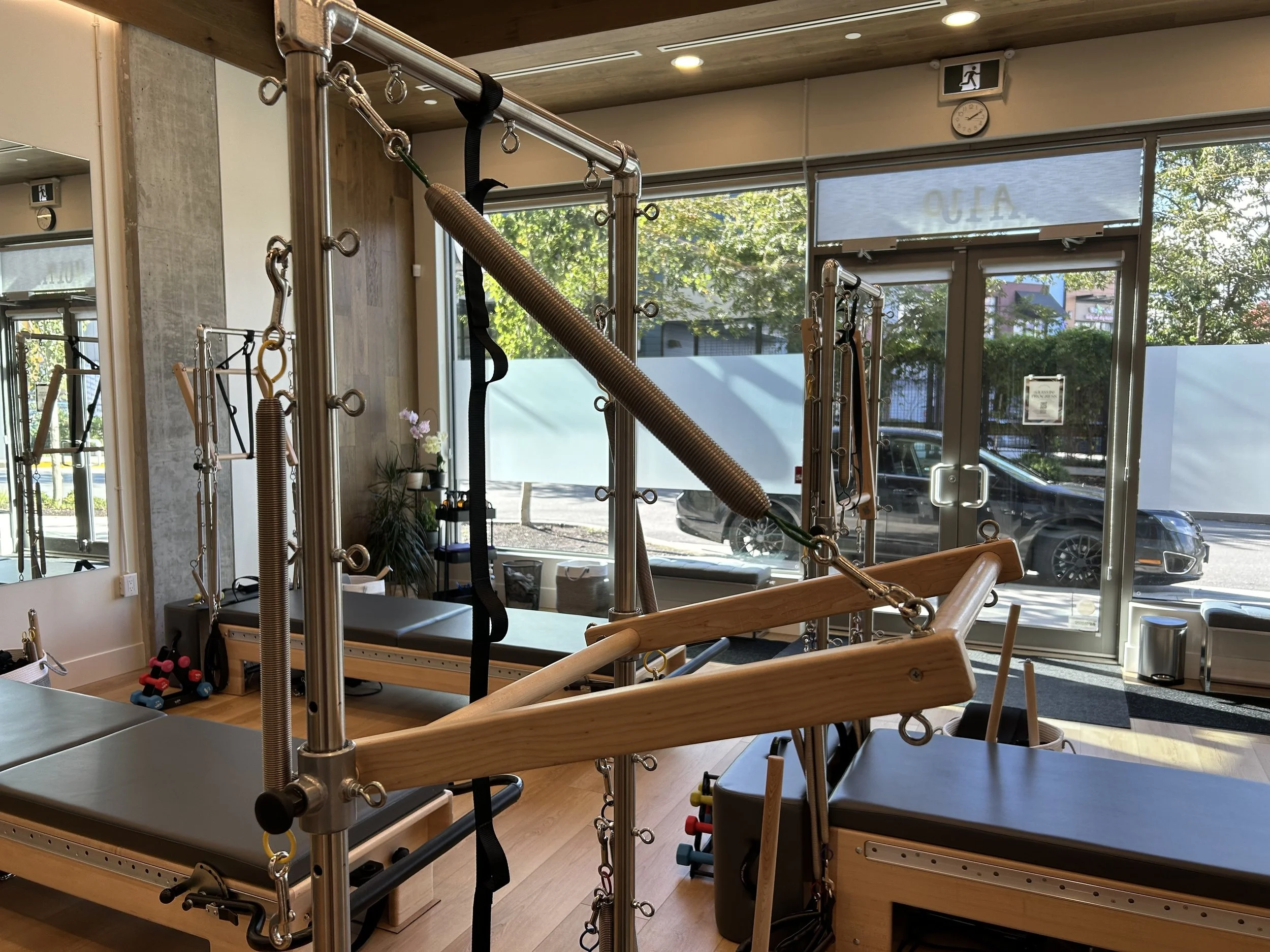The Trapeze Table & Tower
Several weeks ago I posted an article about the history of Pilates and why it’s recommended by health professionals to add Pilates workouts to your current exercise routine. If you missed reading it, please head to my blog to take a peek.
I created a series exploring each piece of Pilates equipment (aka apparatus) with the history and benefits of each. Last week I wrote about the Reformer. Today we explore the Trapeze Table (aka Cadillac) and it’s adaptation the Tower :)
Trapeze Table/ Tower History
In Joseph Pilates’ New York studio, there was an extra room reserved for private clients with more serious muscle imbalances and injuries (Grootenhuis, 2019). There housed the Trapeze Table, and older versions called the Massage Table or Rehabilitation Table (Grootenhuis, 2019).
The original was a massage table with a metal frame attached to one or both ends (Grootenhuis, 2019). This metal frame had eyelets where arm and leg springs, as well as, the roll down bar could be attached at different heights. Besides the Table – or Table with Trapeze as it was also called – there was also a Reformer in this special private room (Grootenhuis, 2019).
According to Romana Kryzanowska, Joseph Pilates main predecessor, the name ‘Cadillac’ was given to the Trapeze Table by a customer of Joseph Pilates in the 1940s (Grootenhuis, 2019). The Cadillac, a General Motors car brand, was known for its high end luxury during the first half of the 20th century (Grootenhuis, 2019). Just as comfortable and special as a real Cadillac, the higher cushiony mat of Joseph Pilates’ Cadillac was also suitable for people who were older, and those with injuries and other issues (Grootenhuis, 2019).
Because the Trapeze Table is very large, Wall Units and Tower attachments were designed which combines both sides of the Trapeze Table into one. A huge space saver!
Wall Units have a cushioned mat on the floor with a Tower unit bolted to the wall. The Tower attachment is the same as the Wall Unit, but instead of bolted to the wall it’s securely attached to one end of the Reformer frame.
Here at Pilates Life Studio, in our private room we have a full Trapeze Table, while in our main studio we have Tower units as pictured below.
Trapeze Table/ Tower Elements
Unlike the Reformer, which moves back and forth on rails, the Trapeze Table/Tower remains stationary (Manheim, 2020). Positioned on the cushioned mat, we hold either handles or bar attached to springs of varying tension (Manheim, 2020).
The stable base of the Trapeze Table/Tower makes this apparatus less intimidating than the Reformer with its moving parts (Manheim, 2020). The Trapeze Table/Tower is ideal for beginning students, as well as, those who are recovering from injuries (Manheim, 2020). There’s very little pressure on the joints because your body weight is supported by the cushioned mat (Manheim, 2020).
The Trapeze Table/Tower is also perfect for seasoned students of Pilates, as we can slow down and focus on spinal articulation exercises that connect us deeply to our core. Also the springs can be adjusted to challenge our muscles during the concentric (shortening phase), as well as, the eccentric (lengthening phase) of the contraction. Studies demonstrate focusing on the eccentric phase of muscular contractions leads to greater strengthening, as well as, increased flexibility if performing the exercises through full ranges of motion.
Arms & Legs Springs
At the studio we have therapeutic yellow arm springs and stronger classical grey arm springs that are connected to handles we hold with our hands to strengthen our upper body. We place our feet inside the loops that attach to either lighter purple leg springs or the more challenging red leg springs to work the lower body.
Roll Down Bar
The Roll Down Bar is an assisted roll up, which helps students find the right muscular connections to become very strong in the abdominals. This bar is also used to strengthen the arms, upper back, and back of hips and legs.
Push Through Bar
This special bar’s main purpose to challenge our core by spinal articulating in all the spine’s natural movements: flexing, extending, rotating, and side bending.
Trapeze Table/ Tower Benefits
Joseph Pilates created more than eighty exercises for the Trapeze Table (Alpers et al., 2002). The exercises are designed to correct particular imbalances with the main goal to help students move more quickly toward an uniformly developed body (Alpers et al., 2002).
Like the Reformer, the Trapeze Table/Tower exercises build leg strength, upper body power, spinal mobility, and spinal stability - with the primary focus of moving from our Powerhouse, our core (Alpers et al., 2002).
The whole Pilates Method is connected. The exercises we do on the Pilates Mat are enhanced on the Reformer, which we can feel from another angle on the Trapeze Table/Tower. All pieces of Pilates apparatus help us dig deeper into the Work of Pilates in an uniquely beneficial way. When we practice our Pilates on all pieces of apparatus we have the opportunity to build more muscular balance to do all the things we want to do in our daily lives with ease, strength, and vitality.
Ah, the beauty of the Pilates Method!
Resources
Alpers, A. T., Segel, R. T., & Gentry, L. (2002). The everything Pilates book: The ultimate guide to making your body stronger, leaner and healthier. Adams Media.
Grootenhuis, R. (2019, May 29). The History of the Pilates Cadillac. Pilates Anytime. https://www.pilatesintel.com/2019/05/history-of-pilates-cadillac-reiner-grootenhuis/
Manheim, A. (2020, August 10). Benefits of the Pilates Cadillac and Tower [Pilates Anytime]. https://www.pilatesanytime.com/blog/equipment/benefits-of-the-pilates-cadillac-and-tower
TecnoPilates. (2024, October 15). Heritage Cadillac. TecnoPilates. https://www.tecnopilates.it/pilates-equipment/it/product/heritage-cadillac/






